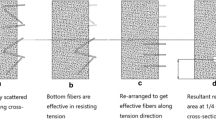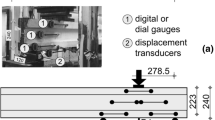Abstract
Steel fibre-reinforced concrete (SFRC) is being used in a variety of structural applications, yet there is still considerable debate how to express and evaluate flexural toughness for design purposes. This is holding back the material's development as a permanent structural material. Existing beam and slab test methods have problems with variability or their application in structural design. Furthermore, existing models of SFRC flexural behaviour do not fully capture what happens at the cracked section in terms of the fibre-matrix interactions. Typical of these approaches is the modelling of the tension zone from single fibre pull-out tests, which is problematic in measurement of the load-displacement relationship, the interaction of groups of fibres and the extensive testing required to cover all permutations of fibre geometry.
An alternative approach is proposed where the average pull-out response of the fibres bridging the cracked zone is inferred from flexural beam tests. The characteristic load versus crack-mouth opening displacement behaviour for a particular fibre concrete then forms part of the stress and strain/displacement profile in a flexural analysis to predict moment capacity in a design calculation. The model is explained together with its validation by comparing the predicted load-displacement response for a range of fibre volumes in sprayed and cast SFRC. It is concluded that the analysis of beam load/deflection curves to infer the fibre pull-out response is a viable approach. It offers a promising solution to the need for a flexural design model combined with a practical method of characterizing the tensile contribution of steel fibres.
Similar content being viewed by others
References
Prudêncio Jr LR, Austin SA, Test methods for evaluation of steel fibre reinforced concrete under flexure, paper in preparation.
Alwan JA, Naaman AE, Guerrero P (1999) Effect of mechanical clamping on the pull-out response of hooked steel fibers embedded in cementitious matrices. Concrete Science and Engineering, 1(March): 15–25.
Armelin HS, Banthia N (1997) Predicting the flexural post-cracking performance of steel fiber reinforced concrete from the pullout of single fibers. ACI Materials Journal, 94(1):18–31.
Jones PA, Robins PJ, Austin SA (2005) Predicting the flexural load-deflection response of steel fibre reinforced concrete from fibre pull-out and distribution data, Submitted to Materials and Structures.
Robins P, Austin A, Jones P (2002) Pull-out behaviour of hooked steel fibres. Materials and Structures, 35:434–442.
Casanova P, Rossi P (1996) Analysis of metallic fibre-reinforced concrete beams submitted to bending. Materials and Structures, 29(4):354–361.
RILEM TC 162-TDF (2001) Recommendations of RILEM TC 162-TDF: Test and design methods for steel fibre reinforced concrete – Uni-axial tension test for steel fibre reinforced concrete. Materials and Structures, 34(1):3–6.
ASTM C1018–92 (1992) Standard Test Method for Flexural Toughness and First-Crack Strength of Fibre-Reinforced Concrete (Using Beam with Third-Point Loading). ASTM Annual Book of Standards, Vol. 04.02, (ASTM, Philadelphia, 1992) pp. 510–516.
JCI Standards for Test Methods of Fibre Reinforced Concrete. Method of Test for Flexural Strength and Flexural Toughness of Fibre Reinforced Concrete (Standard SF4). (Japan Concrete Institute 1983) pp. 45–51.
RILEM TC 162-TDF (2002) Test and design methods for steel fibre reinforced concrete. Materials and Structures, 35:262–278.
Ulfkjæ r J, Krenk S, Brincker R (1995) Analytical model for fictitious crack propagation in concrete beam. ASCE J. Engineering Mechanics, 121(1):7–15.
EFNARC (1996) European Specification for Sprayed Concrete, European Federation of national associations of Specialist Contractors and Material Suppliers for the Construction Industry (EFNARC, 1996).
Romualdi JP, Mandel JA (June 1964) Tensile strength of concrete affected by uniformly distributed and closely spaced short lengths of wire reinforcement. ACI Journal, 61:657–670.
Mindess S (1996) Standard testing. in: High Performance Fiber Reinforced Composites 2. Chapter 10. (ed.) A.E. Naaman and H.W. Reinhardt (E&FN Spon, London, 1996).
Robins PJ, Austin SA, Jones PA (2003) Spatial distribution of steel fibre in sprayed and cast concrete. Magazine of Concrete Research, 55(3):225–235.
Robins PJ, Austin SA, Jones PA (1996) Flexural strength modelling of steel fibre reinforced sprayed concrete in: Sprayed Concrete Technology (E&FN Spon, London, 1996) pp. 107–114.
Canadian Standards Association (1984) Design of concrete structures for buildings (CAN3-A23.3-M84). (Canadian Standards Association, Rexdale, Canada, 1984) pp. 281.
Gopalaratnam VS, Shah SP (1985) Softening response of plain concrete in direct tension. ACI Journal, 82(3):310–323.
Author information
Authors and Affiliations
Rights and permissions
About this article
Cite this article
Prudencio, L., Austin, S., Jones, P. et al. Prediction of steel fibre reinforced concrete under flexure from an inferred fibre pull-out response. Mater Struct 39, 601–610 (2006). https://doi.org/10.1617/s11527-006-9091-2
Received:
Accepted:
Published:
Issue Date:
DOI: https://doi.org/10.1617/s11527-006-9091-2




